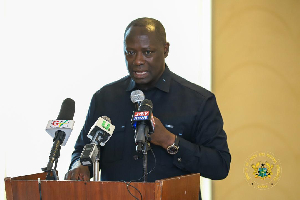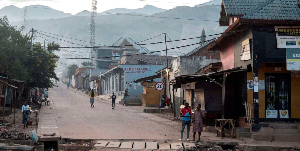(Feature by Francis Ameyibor, Development Communicator)
Accra, Oct. 16--- A recent trip along the eastern corridor revealed a mass infrastructural development, expansion of townships and villages. One would have expected me to be excited about the developments but on the contrary, I was sad.
I came face-to-face with the harmful impact of horizontal development of towns and villages on our forestry, river bodies and echo system; as we are ignorantly or by strategic design destroying the once green forest which greets us anytime we approach a village especially from the cities.
I observed that a stretch of land that had been either a farmland or forest for the past ten or twenty years has now been reduced to townships. Rivers have dried up, lagoons have become dumping sites, whilst we keep on invading forest reserves.
As we developed and expand our townships we are invariable destroying our forest, killing our water bodies, endangering the life of animals and largely the eco system.
I woke up to the realization that Ghana’s forest covers has reduced significantly over the past four decades as much of the forests have been cut down legally or illegally for timber and the remaining are heavily degraded.
Ghana is gradually losing its forest, farmlands and river bodies, “a nation at war with itself”.
Through personal gains and other so called infrastructural developmental ventures “we are degrading the environment:- biodiversity loss; destruction of habitats for animals species and forest dependent people.
Statistics obtained from the National Working Group on Forest Certification revealed that just about a century ago, the nation's tropical hardwood forest extended from about the middle of the country southward to the sea.
Moreover, nearly half the country was covered with forests, which included 680 species of trees and several varieties of mahoganies. But in modern day Ghana most of this wood have been cut.
By the early 1990s, only about one-third of the country was still forested, with commercial forestry concentrated in the southern parts of Ghana.
Ghana Forest Information and Data
According to the United Nations’ Food and Agricultural Organisation, 21.7 per cent or about 4,940,000 ha of Ghana is forested, according to FAO, of this 8.0 per cent representing 395,000 is classified as primary forest, the most biodiverse and carbon-dense form of forest and 260,000 ha of planted forest.
Between 1990 and 2010, the nation lost an average of 125,400 ha or 1.68 per cent per year. In total, between 1990 and 2010, Ghana lost 33.7 per cent of its forest cover or around 2,508,000 ha.
Figures from the World Conservation Monitoring Centre also indicate that Ghana has some 1,185 known species of amphibians, birds, mammals and reptiles out of these, 0.8 per cent are endemic, meaning they exist in no other country, and 3.0 per cent are threatened.
Ghana is home to at least 3,725 species of vascular plants, of which 1.2 per cent are endemic. 4.6 per cent of Ghana is protected
Dr. Ernest Asare Abeney, Director of the NWG, said the stewardship and use of forests and forest land in a way and at a rate that maintains and does not cause damage to other ecosystems.
He therefore called for an efficient management of our forests to reduce the risks and impacts of other negative human approach such as bush fires and airborne pollution among others.
Sustainable Forest Management (SFM) implies deliberate human intervention in policy formulation, legislation and management to safeguard the productive and protective functions of the forest said Dr. Abeney
Mr. Joseph William Osei, a Forestry Economist and Forest Certification Auditor defined forest certification to be an independent process whereby an independent certification body assesses whether or not forest management conforms to a given standard.
Mr. Osei said improvement in forest management requires internal audits and conditions and recommendations from external assessments. In this vein, over 30 forest auditors and local communities have been sensitized on their rights and obligations under forest management, resulting in the use of local communities in deriving more benefits from Social Responsibility Agreements (SRA).
Emmanuel Amoah Boakye, Executive Secretary, Working Group on Forest Certification explained that Voluntary Partnership Agreement (VPA) in the forestry sector in Ghana could be part of a bigger solution.
In responds to the threat, the European Union (EU) signed the VPA with Ghana in 2009 to ensure that all timber harvested in the country for export to EU member countries and domestic market come from legal sources.
The VPA is a bilateral agreement between the EU and timber exporting countries which aimed at improving forest governance and ensuring that the timber imported into the EU has complied with legal requirements of the partner country.
In view of recent developments Dr Ernest Asare Abeney, Chairman of NWG explained that the growing environmental awareness and consumer demand for more socially responsible businesses through certification emerged in the 1990s as a credible tool for communicating the environmental and social performance of forest operations.
He noted that forest certification is an important tool for those seeking to ensure that the paper and wood products they purchase and use come from forests that are well-managed and legally harvested that certification standard was developed as the basis for assessing forest management of all types and sizes in Ghana.
He noted also that forestry plantation had become a necessary and important means for meeting the growing national wood demand, whilst reducing the pressure on the natural forests as the only source of wood for both commercial and household uses.
He said the importance of using, for instance, some modern fast growing species to reclaim mined out sites, reforestation of heavily degraded native forests or forests devastated by wildfires and other natural disasters, underpinned the relevance and growing interest of plantation development in Ghana.
Dr Abeney urged stakeholders, especially forest managers to work hard to sustain the trend by adhering to the certification standards in their operations.
This, he said, would help conserve the forests and biodiversity whilst reducing the burden on governmental agencies to monitor illegal trade in forest produce by allowing independent verifiers to place a seal on products coming from the forest.
The VPA
The VPA therefore aims to improve transparency and accountability by ensuring that timber or timber products imported into the EU from Ghana have been legally acquired, harvested, transported and exported in compliance with the legal requirements in Ghana.
What will be new under the VPA?
A new system of measuring and reporting compliance to the legal standard (existing law); an improved system of collecting, collating and reconciling transaction data along the entire process chain and a change in ownership and custody of export consignments.
Issuance of legality licenses (for EU destinations) is based on the record of legal compliance and chain of custody and the participation of an Independent Monitor to stimulate improvements in the entire control system, also lend confidence to the market and sustained stakeholder participation in forest policy making
Stakeholder participation
The state of Ghana’s forest calls for all-hands on deck to protect the land. “If we fail to join forces with state and civil society organisations to protect the forest today, tomorrow we would be described as endangered species”.
The media has a bigger role to play to protect the country’s forest…the need to intensify public education on impact of infrastructural development especially horizontal expansion on lands.
“We need to help our farmers and traditional rulers to reduce the sale of farm lands, encroachment of forest reserves and other harmful environmental practices…we are all at risk”.
Opinions of Thursday, 17 October 2013
Columnist: Ameyibor, Francis














